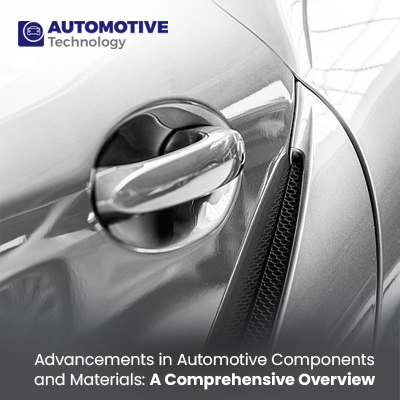Advancements in Automotive Components and Materials: A Comprehensive Overview

Introduction
The automotive industry is constantly evolving, driven by technological advancements and consumer demands for safer, more efficient, and environmentally friendly vehicles. One of the key aspects shaping this evolution is the development of automotive components and materials. From lightweight materials to advanced electronics, these elements play a crucial role in enhancing vehicle performance, durability, and overall user experience.
Evolution of Automotive Components
Over the decades, automotive components have undergone significant transformations. Early automobiles were simple machines with basic components such as engines, chassis, and wheels. However, with the advent of mass production techniques pioneered by companies like Ford, the automotive industry witnessed a revolution in component manufacturing. This led to the standardization of components and the assembly line process, making vehicles more affordable and accessible to the masses.
Materials Revolution in Automotive Industry
One of the most notable advancements in the automotive industry is the use of advanced materials. Traditionally, automobiles were primarily made of steel, which offered strength and durability but also added weight to the vehicle. However, with the need for fuel efficiency and environmental sustainability, manufacturers have turned to lighter materials such as aluminum, carbon fiber, and composite materials. These materials not only reduce the overall weight of the vehicle but also improve fuel efficiency and performance.
Impact of Advanced Materials on Vehicle Performance
The adoption of advanced materials has had a profound impact on vehicle performance. Lightweight materials like carbon fiber and aluminum contribute to better acceleration, handling, and braking performance. They also enhance the overall structural integrity of the vehicle, making it safer in the event of a crash. Furthermore, these materials have opened doors for innovative design possibilities, allowing automakers to create sleeker and more aerodynamic vehicles.
Advancements in Electronics and Connectivity
In addition to materials, automotive components have seen significant advancements in electronics and connectivity. Modern vehicles are equipped with a wide array of electronic components such as sensors, cameras, and control units that enhance safety, convenience, and entertainment. Features like adaptive cruise control, lane departure warning, and automatic emergency braking are made possible by sophisticated electronic systems integrated into the vehicle's architecture.
Challenges and Considerations in Automotive Component Development
Despite the progress made in automotive component technology, several challenges and considerations must be addressed. One of the primary challenges is the cost associated with advanced materials and electronics. While these technologies offer numerous benefits, they can also drive up production costs, which may affect the affordability of vehicles, especially for mass-market segments.
Additionally, ensuring compatibility and interoperability among different components and systems remains a crucial consideration for seamless integration and functionality.
Future Trends in Automotive Components and Materials
Looking ahead, the automotive industry is poised for further innovations in components and materials. Electric and autonomous vehicles are driving new requirements for lightweight yet robust materials that can withstand the demands of electric powertrains and advanced autonomous systems. Additive manufacturing, also known as 3D printing, is another area of interest, offering opportunities for rapid prototyping, customization, and material optimization. Moreover, the integration of AI and machine learning algorithms into automotive components is expected to revolutionize vehicle performance, diagnostics, and predictive maintenance.
Sustainability and Environmental Considerations
Alongside performance improvements, the automotive industry is increasingly focused on sustainability and environmental considerations in component and material development. This shift is driven by factors such as regulatory requirements, consumer preferences for eco-friendly products, and the need to reduce carbon emissions. Manufacturers are investing in research and development to create sustainable materials, including recycled plastics, bio-based composites, and renewable energy sources for vehicle propulsion.
The adoption of electric vehicles (EVs) is a significant step towards environmental sustainability. EVs utilize advanced components such as lithium-ion batteries, electric motors, and regenerative braking systems, reducing reliance on fossil fuels and lowering emissions. Additionally, the recycling and disposal of automotive components, particularly batteries, are being addressed through initiatives focused on closed-loop systems and circular economy principles.
Integration of Advanced Safety Features
Safety is paramount in automotive design, and advanced components and materials play a crucial role in enhancing vehicle safety. Modern vehicles are equipped with a range of active and passive safety features, including airbags, anti-lock braking systems (ABS), electronic stability control (ESC), and advanced driver assistance systems (ADAS). These components work together to prevent accidents, mitigate crash forces, and protect occupants in the event of a collision.
ADAS technologies, such as adaptive cruise control, lane-keeping assist, and automatic emergency braking, rely on sensors, cameras, and processing units to detect potential hazards and assist drivers in avoiding accidents. These systems not only improve safety but also pave the way for autonomous driving capabilities, where vehicles can navigate and respond to road conditions without human intervention.
Global Supply Chain and Manufacturing Challenges
The automotive industry operates within a complex global supply chain, which presents challenges and opportunities for component and material manufacturers. Supply chain disruptions, geopolitical factors, and fluctuating raw material prices can impact production schedules and costs. Manufacturers must collaborate closely with suppliers, adopt agile manufacturing practices, and leverage digital technologies like supply chain analytics and predictive maintenance to mitigate risks and optimize operations.
Furthermore, regulatory standards and quality control processes play a critical role in ensuring the reliability, performance, and safety of automotive components. Manufacturers must comply with industry standards, conduct rigorous testing and validation procedures, and implement continuous improvement initiatives to meet customer expectations and regulatory requirements.
Conclusion
In conclusion, automotive components and materials continue to evolve at a rapid pace, driven by technological advancements and market demands. From lightweight materials to advanced electronics, these elements play a critical role in shaping the performance, safety, and user experience of modern vehicles. As the industry moves towards electric and autonomous vehicles, the development of innovative components and materials will remain a key focus area, ensuring that future vehicles meet the evolving needs of consumers and regulatory standards alike.



